Rome Diary - Part V
June 1
The British School at Rome launched a book of photos of the Abruzzo region taken by its first student, Thomas Ashby, with a spectacular function. Photos were displayed in the gallery, guest speakers and an opera singer presented in the lecture theatre, and food traditional to the Abruzzo region was laid out in the courtyard.

Photo: Opera and Al Fresco dining at the BSR book launch. (Photos from BSR Archive)
https://www.facebook.com/photo.php?fbid=115093451913110&set=a.115092701913185.28617.100002373675816&type=1&theater
A notice advised us all to dress appropriately, and I understand a royal visitor was present. Some of the artists passed on the fancy spread as we had agreed to go out for dinner with Dr Robert Coates-Stephens, in appreciation for our inclusion in his City of Rome excursions. His local knowledge lead us to a no-frills bar in Trastevere, and then to a restaurant called Rigatoni Democratici - one assumes their pasta is of the people, by the people and for the people! After a great rustic meal with Sicilian wine and a black current digestive, we returned to the bar and did not get home until very late... or early, according to your perspective. Sorry, no photos allowed! :>)
June 2
The Wednesday evening lecture was on English society in 18th century Italy, presented by Simon Macdonald. He explained that while Italy was a haven for British Catholics, Anglicans found it difficult to practise their religion. The first concession was a Protestant burial ground (near the Pyramid of Cestius), even if the local perspective was more of isolating the apostates, than recognising their faith. Family portrait paintings from the period were remarkable for the detail contained within limited dimensions. I associate this reduced scale with portability, which has been my consideration, but it seems this correlates to the modesty considered appropriate for domestic content.
I found myself sitting across from a new face at the dinner table, and met Carole Robb the Head of Painting at the New York Studio School, who once taught David Serisier, the deputy Head Painter at National Art School. Later in the evening Carole and a few colleagues came to my studio for drinks. It felt surreal to have the teacher of my teacher in my studio in Rome!
June 3
Went out with some of the academics in the evening. The walk took us to the top of the Spanish steps, providing stunning views, and then on to the Piazza del Quirinal.

Photo: Peter leads the way to the Spanish Steps with St Peters dome on the skyline.

Photo: Piazza del Quirinale with Palazzo Quirinal, left and Scuderie del Quirinale, right.
Opposite the Quirinal Palace is the Scuderie del Quirinale. What was once the royal stables is now an art gallery, currently hosting an exhibition on Lorenzo Lotto. I knew very little about this Italian High Renaissance painter but thoroughly enjoyed the show.
Lotto defies simple categorisation. He seemed retro in some cases, reviving the medieval icon with a theatrical touch (saints with large expressive hands, exaggerated attitude) with intense colours and hard edge clarity that denies the atmospheric sfumato of the. Renaissance. But he also seemed to anticipate the Baroque with Carracci-like colours and Carravaggesque light.

Photo: Lorenzo Lotto, Madonna with Child, St Catherine, and St Jacob. c. 1533. Oil on canvas.
His Annunciation, with clunky figures frozen in motion, borders on surreal.

Photo: Lorenzo Lotto, Annunciation c. 1527 Oil on panel.
...and yet his portraits are sensitively and naturally rendered.

Photo: Lorenzo Lotto, Andrea Odoni, c. 1527. Oil on canvas.
Lotto straddles both naturalism and fantasy. One senses his idiosyncratic style is related not to a Mannerist affectation, but his deep religious conviction. He struggled to find patrons toward the end of his career, and ended his life a disillusioned lay brother. The vivid colours dim in his later darker paintings, although his final work Presentation in the Temple, is bleached by light. It is strangely moving. This may be due to the empty chamber that occupies the top half of the painting in contrast to the altar in the bottom, upon which the infant Jesus is to be placed. The gallery plaque said it includes a self portrait. I like to think it is the semi-transparent figure passing through the doorway above, creating a departing response to the arriving infant.


Photo: Lorenzo Lotto, Presentation in the Temple c. 1555 Oil on canvas.
Alice, who seems to be the assistant for everything at the BSR knows the best gelaterias in Rome, and we had an amaaazing icecream on the way home.

Photo: Alice at a gelateria that bears her name.
June 5
Most of this week has been spent in the studio trying to finish work for our end of term show. This relative isolation was relieved by a visitor late in the afternoon - a former classmate who has been living in Italy for almost two years. It was great to catch up with Lisa Walsh and interesting to hear a perspective on the difficulties facing those in the living city, verses the ancient charm I have been responding to.
June 8
The Wednesday evening lecture was on stigmata, a religious phenomena involving the wounds of Christ. St Francis is the original and most famous recipient of this miraculous affliction, however Dr Cordelia Warr was concerned with subsequent claims to the phenomenon and the professional rivalry it seemed to provoke between the Fransiscans and the Domenicans. Her lecture titled “Alternative Stigmatics”, included images by Sian Bonnell, the Photoworks Fellow and my immediate neighbour, who assumed the guise of Saint Catherine of Siena in her dressing gown by her studio window. While there is an element of humour in performances that include various home-made halos, the images are compelling because Sian immersed herself in the role, and they evoke a strange empathy for the peculiar neurosis she not only represents, but appears to be experiencing.

Photo: Sian Bonnell with an untitled photo produced in a collaboration with Cordelia Warr.
Sian is also keeping an on-line diary: http://www.photoworksuk.blogspot.com/
June 9
With preparations for our mostra (exhibition) largely completed we enjoyed a night out at the German Academy, a compound including ten fantastic studios provided as one year fellowships to mid career artists, a large garden with faux ruins, and the palatial Villa Massimo.


Photos: German Academy in Rome and Villa Massimo.
An Asterix and Obelix style feast was laid on providing beer, pork and sausage to what seemed like a crowd of thousands, but without a salad leaf to be found. Even so, it was a good night out with great company.

Photo: (Left to right) Richard, Di and Sian (fellow artists), John Gill (BSR Faculty of Fine Art Chair)
and Jacopo Benci (BSR Fine Arts Director) at the Villa Massimo.
June 10
Our opening night.
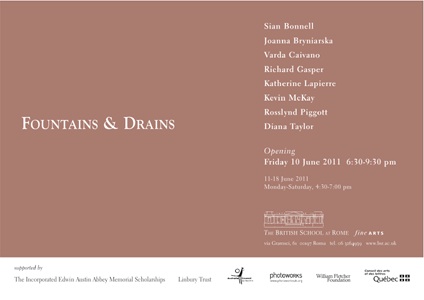
I finished my last painting and hung it on the wall at 2 pm, which gave me just enough time to get a haircut at the barber behind the Pantheon, pick up a nice shirt, and a cheap pair of sunnies for a group photo on the BSR steps that Sian organised before the show.
It was fun adopting the movie star look, even if I don’t have the style!
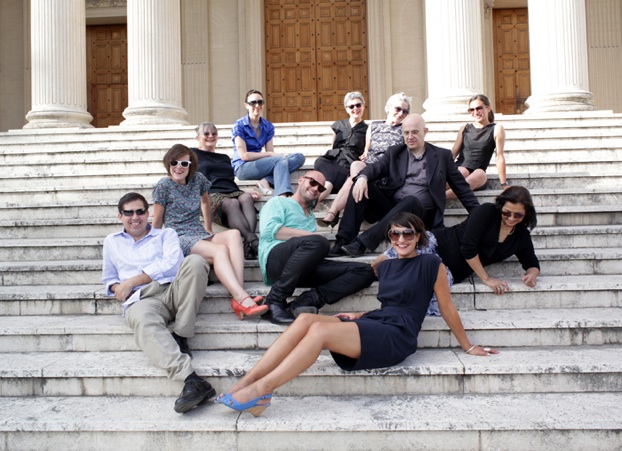
Photo: The BSR Eleven. Clockwise from bottom left: KM, Joanna Bryniarska, Sue Russell (Deputy Director) Varda Caivano, Sian Bonnell, Rosslynd Piggott, Katherine Lapierre, Jacopo Benci (Fine Art Director), Geraldine Wellington (Residence Manager), Diana Taylor and Richard Gaspar.
With thanks to Sian Bonnell http://www.photoworksuk.blogspot.com
The BSR steps have seen some real star power. The facade appeared in the sequel to Ocean’s Eleven as the gallery intended to be robbed. The National Gallery of Modern Art next door was too pricey, so Brad Pitt, George Clooney, Julia Roberts et al hung out in our courtyard for a couple of days instead.
Our show attracted a small crowd by comparison to the other academies, however they filled out the modest confines of the BSR. Visitors included the American conceptual artist, Joseph Kosuth (in the black hat below).
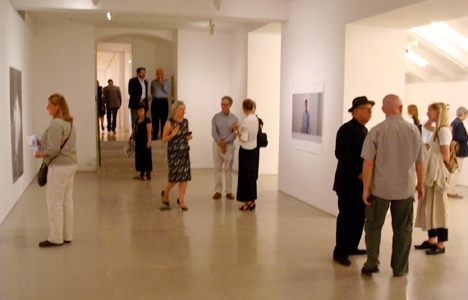
Photo: Mostra opening. (photo Liz Richley.)
Two visitors said the work was better then that at the German Academy... which is significant considering they were from the German Academy!
The show was spread through two large rooms connected by a hallway.


Photos: Fountains and Drains, main galleries.
My contribution of eleven small paintings were hung in a chamber in the connecting space.
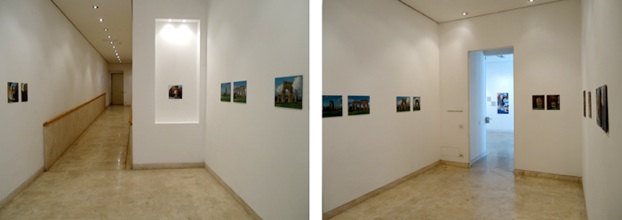
Photo: My work in the connecting chamber between.
This seemed the perfect venue for work featuring arches and pillars as monumental forms framing a passage.


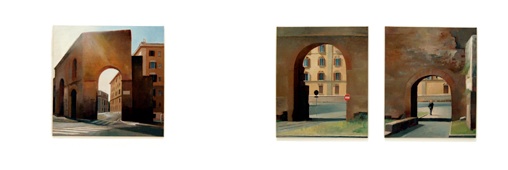
Photos: Paintings included in Fountains and Drains, the BSR end of term exhibition.
The exhibition opening became an end of term party with Richard Gasper, The Sainsbury Scholar in Painting and Sculpture, cranking up the music. I assisted Sian behind the bar, and the dining hall served as a dance floor, which was rocking until the early hours.
11 June
The day after such a great night seemed a little sad. With just over two weeks to go I am now in the tail end of the residency, as the whole school anticipates the end of their academic year.
Decided it was time to check out the National Gallery of Modern Art next door. A show on the Pre-Raphaelite painters was in its final days. This mid 19th century British art movement was inspired by Italian art from the early and pre Renaissance, and it seemed an appropriate venue to spend a mellow afternoon. A small Giotto panel was included and the regular collection included some inspiring work covering the last couple of centuries.
I stole this photo of a Di Chiricho self portrait.
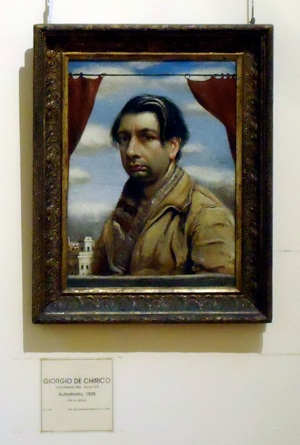
The Futurist work was a worry. Their geometric “purity” celebrates the machine-like consciousness of the fascist regime. I like to think an interest in concrete architectural forms can be balanced by the less tangible qualities of light and atmosphere.
I wandered through the city at the end of the day, down to the Forum Boarium and back along the river, enjoying the evening ambience.

June 14
Checked out the art collection at the Barbarini Palazzo.
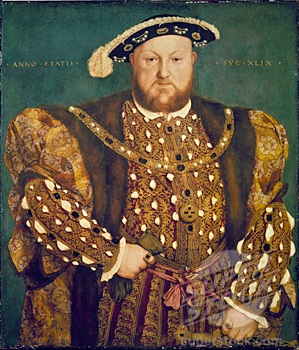
Photo: Hans Holbein, the Younger, King Henry VIII, 1540. Oil on panel.

Photo: Caravagio, Narcisus, c 1598. Oil on canvas, 110 x 92 cm.
There were a couple of Pousins.
This is one of two small paintings of cherubs indulging in a Bacchanale feast.
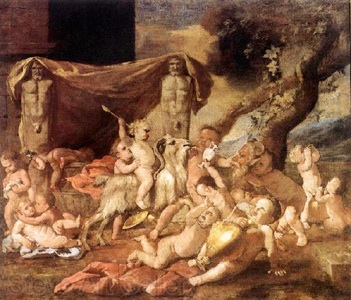
Photo: Nicholas Pousin, Bacchanale with Putti, oil on canvas, 1626.
They were both painted soon after Pousin came to Rome. The riotous cherubs are contrasted by stoic male pillars (hermes); architectural elements, trees, and drapery in the middleground interface with the foreground figures and background landscape; while the paint varies between thin washes and freshly applied impasto.
Landscape dominates his later work, Landscape with Hagar and the Angel, a more sombre painting of an Old Testament story in which Abraham’s concubine is banished and heads out of the painting beneath a threatening sky.
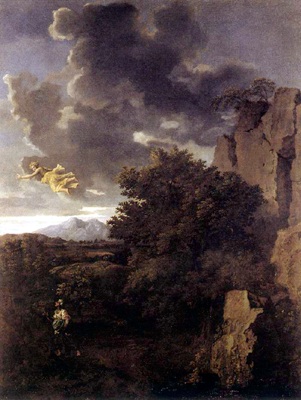
Photo: Nicholas Pousin, Landscape with Hagar and the Angel. c 1660.
The main hall at the Barbarini Palace is flanked by two staircases. One squared staircase by Bernini and a continuous elliptical spiral or helicoidal staircase by Borromini.

Photo: Bernini’s staircase left, and Borromini’s right.
Stopped by the Trevi fountain, where visitors toss coins to ensure their future return to Rome. The site was packed with so many wishful tourists I decided to make my symbolic contribution later.
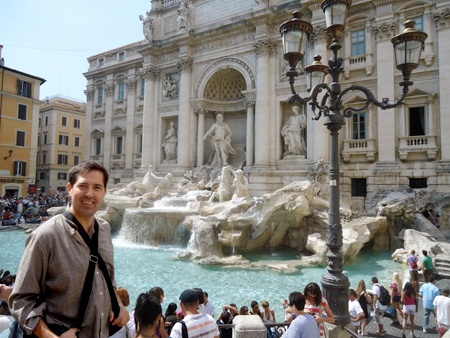
Photo: Being a tourist at The Trevi Fountain...
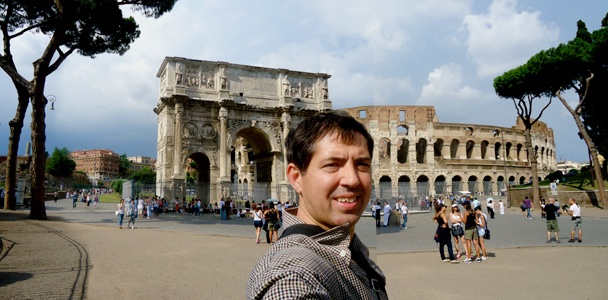
Photo: ...and at the Colosseum with the Arch of Constantine.
Wandered past the Colosseum, and down to the Baths of Caracalla, with an intention of getting pics in the late afternoon light. The front of the site had been largely taken over by scaffolding for a rally, and a thunderstorm robbed me of the golden light, but it is still an impressive place.

Photo: Baths of Caracalla.
June 15
Decided it was time to face the crowds at the Vatican. Went mid-morning, mid-week when the Pope does his meet and greet, hoping it might thin the numbers at the museum. It was still busy, but not as bad as I feared.
An oddly angled panel on the side of an entrance arch seemed designed to expand the perception of its depth, like Borromini’s forced perspective arcade at Palazzo Spada.
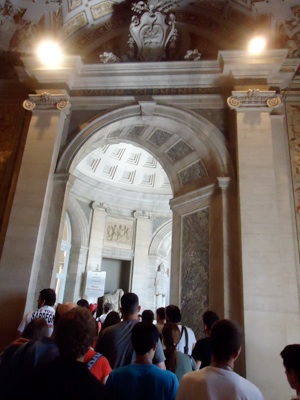
Photo: Entrance to the Vestibolo Quadrato, Museo Pio Clementino.
Domes abound at the Vatican. The Sala Rotunda directly references the Pantheon as its model. Ancient statues line its perimeter, including a gilded statue of Hercules.
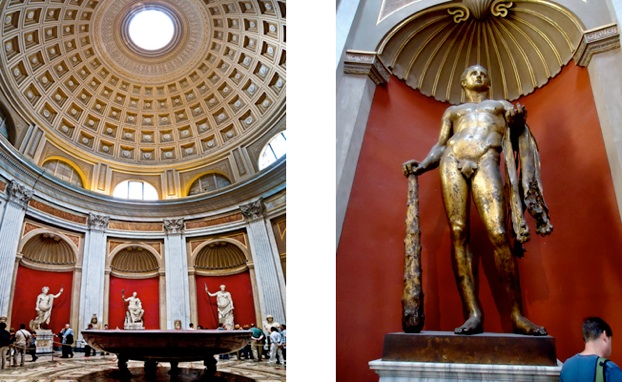
Photo: The Sala Rotunda and gilded Hercules.
Halls lined with marble statues of every kind and creature seem to go for kilometres.
I located the famous Laocoon and His Sons wrestling with the sea serpent.
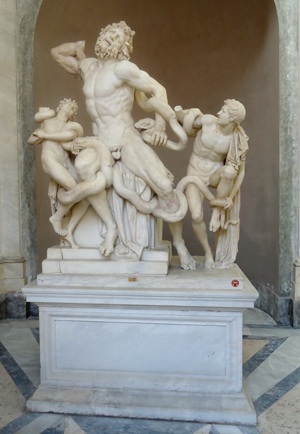
Photo: The Laocoon and His Sons.
The discovery of this ancient work in 1506 led to it being put on public display at the Vatican a month later, so the origin of the Vatican Museum can be attributed to this single work.
The frescos in Raphael’s Rooms was a highlight. Raphael was 27 when he painted The School of Athens, seen by many as heralding the High Renaissance.
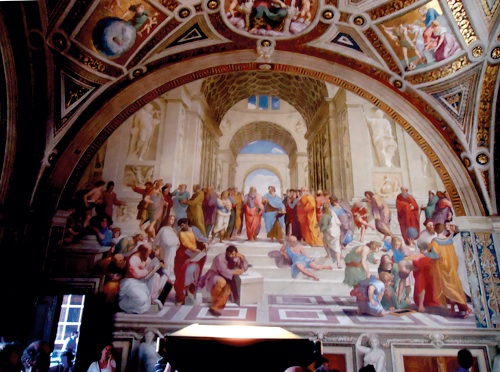
Photo: Raphael’s “School of Athens” makes art smart at The Vatican.
This mural was part of a cycle in a papal library where each wall represents the theme of poetry, philosophy, justice and theology in a progressive hierarchy. Raphael used portraits of contemporary painters to depict Greek philosophers, a clever way to network and to raise the status of picture makers. Leonardo fills the central role of Plato, and points skyward in contrast to Aristotle who makes a more down to earth motion with his hand.
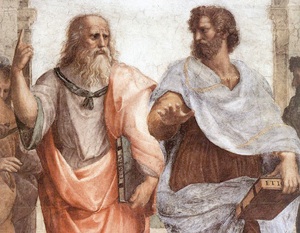
This is understood as representing the different emphasis of each great man. Plato concerned with the theoretical ideal, and Aristotle with empirical knowledge. Mind you, Leonardo’s sketchbooks establish observation as the core to his genius.
One could also relate these gestures to the dual concerns of painting, the illusionary space beyond the picture plane and the material issues of surface, and the “push and pull” process. I also like the way each receding arch appears within the span of those in front, with the whole composition contained within an arch.
Sections of the picture galleries were closed so I missed out on a lot of paintings.
The modern art section contained many forgettable “crucifixion” paintings, but there was a Francis Bacon portrait of the Pope, and after all the blockbusters, I enjoyed a couple of quiet Morandis.

Photos: Paintings by Giorgio Morandi at the Vatican
After a long walk down brightly lit corridors, I entered a crowded, dimly lit hall with guards telling everyone to keep moving. It felt like a strange train station, until I looked up and I saw Michelangelo’s amazing ceiling. Using the long tradition of illusionistic architectural forms Michelangelo framed stories from the bible, adding prophets and sibyls to the margins, which link the figures within the window narratives to the frame and perceptually with our three-dimensional space. The colours are striking and the creative energy palpable. It felt more like an artists studio on steroids than a chapel! I was surprised to see God's posterior next to the better known panel featuring the iconic hand of God.

Photo: The Creation of the Sun, Moon and Earth, Sistine Chapel Ceiling.
Could not linger as long as I wanted in the Sistine Chapel, but an earlier wall painting by Botticelli near the exit and one that faced it on the opposite wall by Perugino caught my eye. Both have victory arches in them.

Photo: Wall frescos by Botticelli (left) and Perugino (right) in the Sistine Chapel.
The gift shops that followed seemed as endless as the halls of marble statues but I finally exited via a double helix staircase.

Photo: The double helix staircase.
The Vatican Museum was well worth the queue!
